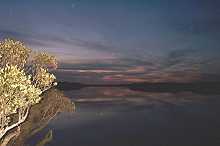|
Challenging Habitats: Southern Saltmarshes
and Mangroves
The information presented here has been written by staff at the
Marine Discovery Centre, Queenscliff, Victoria.
1. Introduction
Both mangrove and saltmarsh (also called samphire in South Australia) habitats have been viewed as worthless in the past as they are generally areas that are muddy, smelly because of the lack of air in the mud, and full of mosquitoes. Many areas that formerly were covered in saltmarsh or mangroves have been cleared to create housing estates, marinas, resorts, and farm land. They are challenging habitats for conservation as people find them hard to enjoy.
|

Mangroves on the Barwon River, Victoria.
|